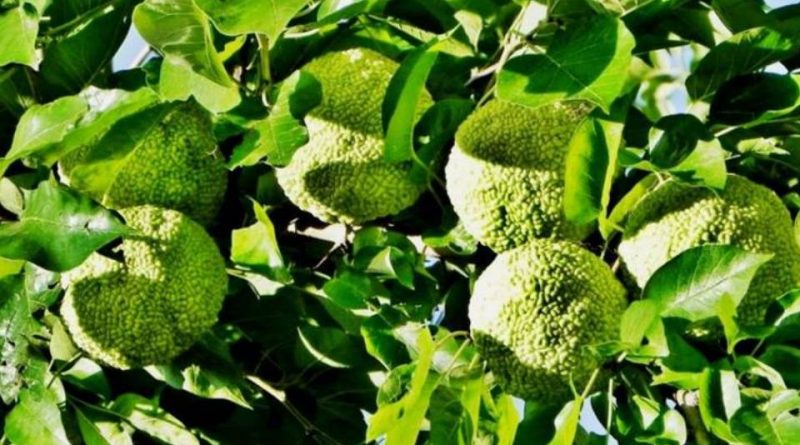Maclura pomifera
Maclura pomifera
The Osage orange (Maclura pomifera (Raf.) C.K. Schneid.), also known as Maclura aurantiaca, is an arboreal species belonging to the Moraceae family.
Systematics –
From the systematic point of view it belongs to the Domain Eukaryota, Kingdom Plantae, Magnoliophyta Division, Magnoliopsida Class, Order Rosales, Family Moraceae and therefore to the Genus Maclura and to the Species M. pomifera.
Etymology –
The term of the genus Maclura was dedicated to the geologist W. Maclure, a friend of the botanist Thomas Nuttall (1786-1859) who was the first to describe the species in America. The specific pomegranate epithet comes from fruit pómum and from féro bring: which has roundish fruits similar to pomes. The term Moro degli Osagi derives from the fact that this tree was well known to the American Indians, in particular, it seems, to the Osage tribe.
Geographic Distribution and Habitat –
Maclura pomifera is a plant native to North America (the area of origin is located in an area of central United States) and was introduced in Europe in 1818 and in Italy in 1827. Maclura was first described by Thomas Nuttall in 1811 who attributed the name of his friend geologist William Maclure.
Description –
Maclura pomifera is a tree species 8-12 meters high with a thick and irregular foliage. The trunk is somewhat tormented with a deeply cracked brown-orange bark containing moderate tannin, while a dye called morina is extracted from the roots. The leaves resemble those of the orange tree, are alternate, sharp, leathery and were also used in the past in feeding the silkworm. It is a dioecious plant, with inflorescences, both male and female, spherical and with a diameter of 2-3 cm. The fruit is a spherical cluster, of variable diameter from 8 to 15 centimeters, green and wrinkled, of woody consistency, with a greenish and wrinkled surface, and with milky juice. The fruit that is a sorose derived from the transformation of an entire inflorescence is not edible.
Cultivation –
Maclura pomifera is a vigorous tree resistant to cold and heat; in past centuries the cultivation of this tree was introduced in most of Italy, from Sicily to the Po Valley where, it has proven to vegetate without problems wherever it was placed at home. The plant, however, needs a well-sunny area, with a rich, fertile and very well drained soil; in fact it adapts practically to any terrain and also to half-shade cultivation. The cultivation in Italy of maclura is however purely as an ornamental tree, used as a single specimen, so that it spreads its foliage, or as a plant to produce tall hedges.
Uses and Traditions –
Maclura pomifera is also known as Texas mulberry, or Osagi orange, or hedge apple-tree, apple-tree of horses, Moor of Osagi and wood of arch.
Maclura pomifera was used in the areas of origin, from the Osage tribe, because of its flexible and elastic wood, for the construction of arches (for which, in Lazio it is also called “wood of arch”) and they were able to to obtain, again from this tree, a yellowish pigment with which the face was dyed.
Thanks to the characteristic thorniness of the plant in the past it was often used for the construction of impassable hedges.
The history of Maclura pomifera is intertwined with that of the silkworm breeding; in fact, around the mid-800s, white mulberries (used for silkworm breeding) began to manifest a particular root infection that quickly brought them to death. This month in crisis the whole sector represented an important and sure source of income for the rural populations of many areas, above all because in it the weak forces of families, women, old people and children were used, while the males of work was engaged in the heaviest and most profitable jobs. To cope with the emergency, the use of this plant was experimented, which for some decades was imported into Europe.
The experimentation was carried for some time in Trentino where, however, at the end it was realized that the nutritional power of the leaves for nourishment of the silkworm had not made comparable with those of the mulberry.
Today it is used in Italy for ornamental purposes or to create impenetrable hedges.
The wood is heavy, hard, flexible, resistant to weather and bad weather, and, inside the trunk, has a wonderful mottled ocher color. For these it can be used for precious craft creations or for the creation of durable tools.
The Indians used its wood as a remedy for conjunctivitis and eye inflammation.
The fruit is much appreciated by the squirrels, while, although not poisonous, it is not edible and causes vomiting if ingested by humans.
Preparation Mode –
Maclura pomifera is a species that today, in addition to ornamental purposes or special processing of timber, has no other food or pharmaceutical uses.
Guido Bissanti
Sources
– Acta Plantarum – Flora of the Italian Regions.
– Wikipedia, the free encyclopedia.
– Treben M., 2000. Health from the Pharmacy of the Lord, Advice and experience with medicinal herbs, Ennsthaler Publisher
– Pignatti S., 1982. Flora of Italy, Edagricole, Bologna.
– Conti F., Abbate G., Alessandrini A., Blasi C. (edited by), 2005. An annotated checklist of the Italian vascular flora, Palombi Editore.
Warning: Pharmaceutical applications and alimurgical uses are indicated for informational purposes only and do not in any way represent a medical prescription; there is therefore no liability for their use for curative, aesthetic or food purposes.


